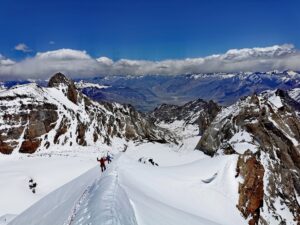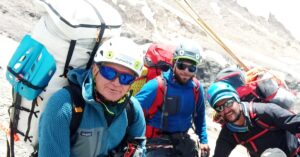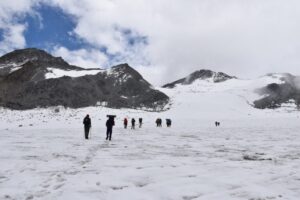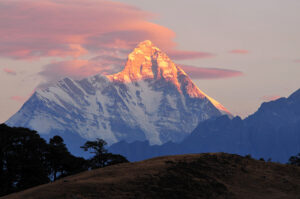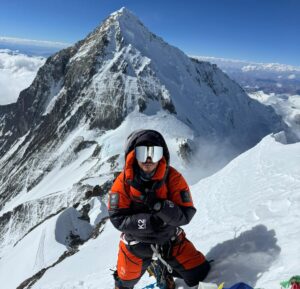We like to think of the Himalaya as a land of explorers, wild souls, and adventurous badasses. But certain things have changed.
These days, there are two kinds of people at the 8,000m base camps: those spending money and those making it from the mountains. Everything else is PR or wishful thinking. But are alpinists who explore new, highly technical routes in isolated ranges so different?
Vocation or avocation
In 2023, climbing — from local bouldering to climbing the most remote Himalayan spire, and definitely Everest — is either a pastime or a profession of some sort. This includes guiding, gear testing, fulfilling sponsorship duties, and working as a social media influencer. Sometimes it’s both vocation and avocation. Basically, mountaineering is leisure. Yet it moves millions.

Everest Base Camp at night. Photo: Pasang Rinzee Sherpa
Earlier this year, the clothing company Eddie Bauer ended its sponsorship contracts with all the alpinists they had supported for years. They decided to rely in future on influencers.
Kristin Harila has received criticism from the classical mountaineering community for the style in which she is attempting to do all 14 8,000m peaks in three months or so. And yet, she keeps gaining new sponsors. Nirmal Purja tries a new pair of sunglasses and gets a million social media likes instantly.
Last month, David Goettler and Benjamin Vedrines launched an impressive, pure alpine-style climb of Nanga Parbat’s gigantic Rupal Face. After two bivouacs, they retreated because Goettler was not feeling well enough on the summit day. They were completely alone on the mountain, and he responsibly chose not to risk his life and his companion’s. They hardly made a headline.

Benjamin Vedrines alone on Nanga Parbat’s Rupal side. Photo: David Goettler
Sophie Lavaud summited Nanga Parbat at the same time, up the well-trodden normal route, with sherpa support, oxygen, fixed ropes, and a film crew. She was featured recently in Paris Match. She is now the first French, Swiss, and Canadian climber to complete the 14×8,000m list.
“Better than Loretan!” some fan enthused on social media.

Sophie Lavaud makes a double-page spread in Paris Match. Photo: Sophie Lavaud/Facebook
It’s understandable if this causes some of us to groan.
Yet to be honest about mountaineering, we have to stop pretending it’s still 1972. We need, alas, to speak of money, social media presence, trends…and, of course, news.
8,000m climbs worthless?
Recently, ExplorersWeb republished a long, analytical piece in which journalist Laszlo Pinter defended the immense amount of work done by Eberhard Jurgalsky and the team at 8000ers.com. He then suggests how these new firsts on 8,000’ers lack any real mountaineering value.
It’s hard to disagree with most of his points when you compare our current 14×8,000m collectors with the pioneers of the previous century. With rare exceptions — such as some of the sherpas who guide them — the current crop of 8,000m climbers are high-altitude tourists, or at best, athletes.

The indomitable Wanda Rutkiewicz at K2 Base Camp. Photo: Polski Himalaizm Sportowy
“The current female serial climbers will never come close to the great female climbing figures, such as Allison Hargreaves, Wanda Rutkiewicz, Lynn Hill, Catherine Destivelle, or Gerlinde Kaltenbrunner,” Pinter writes.
However, being strictly objective, we really don’t know. We can’t read the future.
Visually impaired Jill Wheatley of Canada recently announced that she was quitting 8,000m climbing. She wanted to do something different, harder, more technical. Adrianna Brownlee of the UK, currently around the Gasherbrums, wrote before leaving that she was done using supplementary O2. She too seems to yearn for something harder.
In fact, the Gasherbrums are a great place to start, since until recently, no one used bottled O2 on these two lower 8,000’ers. Brownlee has all the (paid) support that commercial teams provide, and super-sherpa Gelje Sherpa by her side. But she is also 22. She has time to improve her skills.
Would she have earned more positive feedback if she had instead tried the NE Face of Masherbrum? More likely, she would have only prompted contemptuous comments. In the worst-case scenario, she wouldn’t have lived to turn 23.

Viridiana Alvarez of Mexico has summited four 8,000m peaks so far this year, including Nanga Parbat, above. She hopes to round out her list with three more this year.
Indeed, the over-exposed serial climbers will likely finish their quests soon. Then they’ll have to decide what’s next. Do they retire and work the motivational speaking circuit, or try something harder? It’s a big world: perhaps there is a new Wanda Rutkiewicz quietly maturing in Poland or in Pakistan. Someone we never heard of, born in the 21st century.
Perhaps she will show up on some 8,000’er as a member of a bigger team, as Rutzkiewicz or Pasaban did. The likes of Gerlinde Kaltenbrunner, Wanda Rutzkiewicz, and others were not Marvel superheroines from another planet, but women who evolved as they went along.
Stop reporting?
In his article, Pinter states: “It is questionable whether specialist media should even cover guided 8,000m climbers, just like we don’t report about guided Mont Blanc climbs.”

Guide Oleg Ivanchenko takes a selfie on a crowded Everest summit in spring this year. Photo: Oleg Ivanchecko/Facebook
It is an interesting question that we ask ourselves from time to time. Yet the short answer is that we do cover 8,000m climbs for the time being, for a number of reasons.
1. The origins of ExplorersWeb
The original founders of ExplorersWeb, Tom and Tina Sjogren, started the site as a guide for wannabe Everest climbers, based on their own difficulty in finding reliable information. They covered what to look for and what to avoid on Everest. As the site evolved, we covered K2, then the rest of the 8,000’ers, then the Poles and oceans.
The Sjogrens have moved on, but the highest mountains on Earth remain part of ExplorersWeb’s history. Although we’ve evolved too, our job has remained similar. We report news.

Tom and Tina Sjogren after back-to-back South and North Pole expeditions in 2002.
2. Covering news
Our main goal is not to decide which expeditions or climbers are more meritable. We’re not jury members for the Piolet d’Or. And there is still news to report from the higher summits.
When I first wrote for ExplorersWeb between 2004 and 2012, we covered some major issues, from the new routes opened by the likes of Urubko and Steck to tragedies such as the nerve-wracking rescue attempt of Inaki Ochoa de Olza on Annapurna.
We covered races such as the one for the first female 14×8,000m summiter, including the investigation of Oh-Eun Sun’s ultimately false claim on Kangchenjunga. We uncovered other false claims and denounced criminal actions, such as the 2006 killings at Nangpa La. Here, Chinese border guards fired on unarmed refugees trying to flee Tibet into Nepal. The massacre was visible from Cho Oyu Base Camp.
Commercial expeditions, fixed ropes, and sherpa guides were already around at that time. Yet there were compelling stories to share.

Denis Urubko has been a regular on ExplorersWeb for over 20 years. Photo: Denis Urubko
Not too many years ago, it was possible to list everyone who summited, as we did for years on a sister website, now defunct, called AdventureStats. Eventually, the task proved too hard and even pointless. As the number of summits on certain Himalayan peaks changed from single digits to sometimes hundreds in a single day, the achievements stopped being extraordinary.
3. Adding perspective
As Himalayan climbing changed, so did we. Our work is even harder today, because some climbers try to avoid objective coverage in favor of their own Instagram PR. Still, we strive to provide accurate accounts of the latest mountaineering achievements.
We have covered Kristine Harila‘s current project as we did Nirmal Purja‘s in 2019. We have tried to understand complicated achievements such as Winter K2. Even speed, age, and nationality records are sometimes worthwhile to cover because by giving them context, we hopefully stir healthy debate.

Suman Gurung on the summit of Annapurna. Photo: Suman Gurung/Instagram
We may write about Everest and K2, but we are delighted to cover any team opening new routes, exploring isolated ranges, climbing alpine style, and reminding us that there is still plenty of difficult alpinism out there.
However, there aren’t a lot of such teams, and they rarely share dispatches from the field. Most of the time, they keep quiet until they finish. Despite the false impression given by commercial climbers chain-summiting peaks, hard mountaineering goals rarely end in success. It’s why we’re so happy to cover independent expeditions, with or without the summit.

The beauty of high-altitude alpinism. The Ukrainian expedition to Annapurna III, 2021.
4. Shedding light on dark corners
We have also borne witness to the expansion and change of the mountaineering industry. We have seen how oxygen use has multiplied, technology improved, luxury replaced austerity, and how helicopters saved lives but also quenched some of the adventure.
And we asked questions, whether the lords of the game liked it or not. Sometimes they didn’t like it at all. But we continue to sniff behind closed doors and shed light on the darker corners of the high-altitude showcase. If only to prevent audiences from believing everything they see on Instagram.

Grace Tseng and her sherpa team on the upper slopes of K2 last year. Photo: Grace Tseng
“When people like Grace Tseng make headlines in international climbing media, it is embarrassing to mountaineering,” Pinter writes. Thanks in part to ExplorersWeb, we all know (apparently Ms. Tseng included) that she didn’t reach Kangchenjunga’s true summit in 2019. And we have asked many questions about her Manaslu record claims. At the same time, we’ve given her the right to explain herself.
5. Opening cans of worms
As for Manaslu’s true summit, we were the first to see Jackson Groves’ drone images in the fall of 2021. We checked with him for confirmation, asked for permission to publish his images, and we forwarded them to the 8000ers.com team. Groves was a nearly anonymous member of a commercial team, making a living out of his photos and videos. He never reached the main summit himself.
Groves did not even realize what he had discovered when he shared his drone photos online. But we did.
We started mentioning helicopters transporting climbers to and from higher camps on Nepal’s 8,000’ers for reasons other than rescues. Now this is well known, although climbers still try not to speak about it.
We gave voice to climbers who denounced the filthy state of the higher camps on K2 and Everest, published their images, and sought to confirm their testimony. Mainstream media cover dramas, tragedies, and scandals in the mountains, but we provide insight.
Not that we don’t cover tragedies too. I was once accused of “almost hoping for something bad to happen in the mountains,” so we had something exciting to write about. Although we are painfully aware of the tragedy behind every accident, risk is an intrinsic part of mountaineering. It is, unavoidably, news.

Adam Bielecki inside a crevasse on Annapurna, rescuing Anurag Maloo. Photo: Adam Bielecki
Drama may be part of adventure, but so is hope for a miracle (as on Annapurna this past spring). Likewise, heroic actions (like Israfil Ashurli on Nanga Parbat) and happy outcomes. Often, it is when things go wrong that people show their true colors. A lot of lessons emerge that can help prevent similar accidents in the future.
Will we cover the 8000’ers in the future?
The future is uncertain, but realistically, the question is not if we will report, but how. “Those who need a guide to climb a mountain should in no way claim any absolute mountaineering record,” suggests Pinter.
Still, as Eberhard Jurgalski points out, a summit is a summit. A summiter can claim whatever obscure record they want, but it is not necessarily news. Most of the ones that lead to Guinness certificates are not worth a story. They’re just good for the record holder’s social media fans.
Will we keep reporting on Everest teams queuing on the ropes, luxury base camps, and helicopter-assisted shortcuts? Only as long as it’s news. The industry is changing, but there remains a lot to write about. As Horia Colibasanu pointed out, the Himalaya are still a place for adventure. And beyond the fixed ropes, there are many other routes and faces waiting to be featured.

